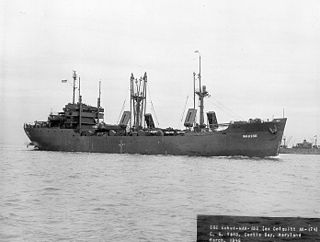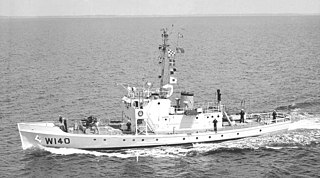
The United States Asiatic Fleet was a fleet of the United States Navy during much of the first half of the 20th century. Before World War II, the fleet patrolled the Philippine Islands. Much of the fleet was destroyed by the Japanese by February 1942, after which it was dissolved, and the remnants incorporated into the naval component of the South West Pacific Area command, which eventually became the Seventh Fleet.

The Philippine Coast Guard (PCG) is recognized as the third armed uniformed service of the country attached to the Philippines' Department of Transportation, tasked primarily with enforcing laws within Philippine waters, conducting maritime security operations, safeguarding life and property at sea, and protecting marine environment and resources; similar to coast guard units around the world. In case of a declaration of war, the Coast Guard shall also serve as an attached service of the Department of National Defense.

USS Asheville, the lead ship in her class of two United States Navy gunboats, was the first ship of the United States Navy named for the city of Asheville, North Carolina. The ship was built at the Charleston Naval Shipyard of North Charleston, South Carolina, from her keel laying in June 1918, her launching in July 1918, and her commissioning in July 1920.

USCGC Juniper (WLB-201) is the lead ship of the U.S. Coast Guard's current class of seagoing buoy tenders. She is outfitted with some of the most advanced technological and navigational capabilities currently available.

USCGC Kukui (WAK-186) was a Maritime Commission Type C1-M small cargo ship launched 21 January 1945, by Froemming Brothers, Milwaukee, Wisconsin, transferred to the Navy and commissioned and designated as USS Colquitt (AK-174) 22 September 1945. Two days later the ship was transferred to the Coast Guard for operation before being permanently transferred on 11 March 1946. Renamed Kukui and designated WAK-186 the ship was the largest in the Coast Guard with notable service installing, servicing and supplying the Loran-A and Loran-C electronic navigation chain stations in the Pacific until March 1972. The ship was transferred to the Philippines to serve as the Philippine Navy's supply ship BRP Mactan (TK90) until June 2001.

The Schichau-Werke was a German engineering works and shipyard based in Elbing, Germany on the Frisches Haff of then-East Prussia. It also had a subsidiary shipyard in nearby Danzig. Due to the Soviet conquest of eastern Germany, Schichau moved to Bremerhaven in March 1945, and its successors continued in business until 2009.

The second USS Willoughby (AGP-9) was a motor torpedo boat tender that served in the United States Navy from 1944 to 1946, seeing service in the later stages of World War II. Transferred to the United States Coast Guard in 1946, she was in commission as the cutter USCGC Gresham (WAVP-387), later WHEC-387 and WAGW-387, from 1947 to 1969 and from 1970 to 1973, seeing service in the Vietnam War during her Coast Guard career.

USS Half Moon (AVP-26) was a seaplane tender that in commission in the United States Navy from 1943 to 1946 that saw service in the latter half of World War II. After the war, she was in commission in the United States Coast Guard as the cutter USCGC Half Moon (WAVP-378), later WHEC-378, from 1948 to 1969, seeing service in the Vietnam War during her Coast Guard career.

The second USC&GS Fathomer was a steamer that served as a survey ship in the United States Coast and Geodetic Survey from 1905 to 1942.

USC&GS Marinduque was a steamer, owned by the Philippine Insular Government, that served exclusively in the Philippines. The ship was purchased by the Philippine Bureau of Coast Guard and Transportation to support both government logistical and administrative travel needs as well as the usual functions of a coast guard vessel. The vessel was transferred to the United States Coast and Geodetic Survey serving as a survey ship from 1905 to 1932. Marinduque and Romblon were sister ships, both built in Japan.

USC&GS Romblon was a steamer, owned by the Philippine Insular Government, that served exclusively in the Philippines. The ship was purchased by the Philippine Bureau of Coast Guard and Transportation to support both government logistical and administrative travel needs as well as the usual functions of a coast guard vessel. The vessel was transferred to the United States Coast and Geodetic Survey serving as a survey ship from 1905 to 1932. Romblon and Marinduque were sister ships, both built in Japan.

The Casco class was a large class of United States Coast Guard cutters in commission from the late 1940s through the late 1980s. They saw service as weather reporting ships in the Atlantic and Pacific Oceans until the early 1970s, and some saw combat service during the Vietnam War.

BRP Ang Pangulo (AT-25) is a presidential yacht that was acquired by the Philippine government in 1959. The yacht was first used by President Carlos P. Garcia.

BRP Gregorio del Pilar (PS-15) is the lead ship of her class of offshore patrol vessel of the Philippine Navy. She is the second ship to be named after Gregorio del Pilar, a Filipino revolutionary general known for his role at the Battle of Tirad Pass. She was originally designated as "PF-15" from 2012 to mid-2016. Then the Navy adopted a new code designation system and she was redesignated as "FF-15". In February 2019, the Navy downgraded the status of the entire class from frigate to patrol ship and redesignated her to "PS-15".

USCGC Legare (WSC-144) was a United States Coast Guard cutter that served in the Coast Guard for almost forty-one years.

Q-111 Luzon was a motor torpedo boat of the United States Army during World War II as part of the Offshore Patrol based at Manila.

BRP Banahaw was a British-built yacht that later served as the presidential yacht of the Commonwealth of the Philippines.
USLHTBanahao was lighthouse tender that served in the Philippines.
Patrol Boat No. 105 (第百五號) (ex-Arayat) was a former Philippine Commonwealth customs inspection and enforcement cutter that was sunk by the Japanese during the invasion of the Philippines and later raised and designated as a patrol boat in the Imperial Japanese Navy.
SSCapillo was a Design 1022 cargo ship built for the United States Shipping Board immediately after World War I.
















